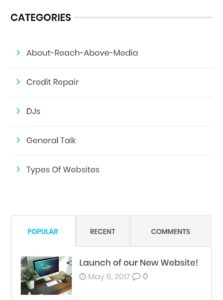SQL stands for Structured Query Language. It is pronounced like the word sequel. It is used to write commands, such as the insert, select, update, delete, create, drop, and other features similar. This also can be integrated in other codes, and can be used for servers.

SQL is created by workers of IBM, who are Donald D. Chamberlin and Raymond F. Boyce.
We’d love to hear your comments about SQL below!
You can also Request a Quote here if you’d like us to help you code your responsive website.
… Read the rest
Throughout the world of web development, there is no language more universally despised than JavaScript. This is how WordPress defines JavaScript:
JavaScript, often abbreviated as JS, is a high-level, dynamic, weakly typed, prototype-based, multi-paradigm, and interpreted programming language.
Confused already? We thought so. Let’s take you through each of those terms step by step.
High-level
Webopedia defines a high-level language (HLL) as “a programming language such as C, FORTRAN, or Pascal that enables a programmer to write programs that are more or less independent of a particular type of computer.” These are generally “closer to human languages and further from machine languages.” Programmers have debated this topics for more than a decade, stressing that a language that is human-like will deteriorate with time.
Dynamic
Sure, JavaScript is a dynamic language and is known for affecting the behavior of a website. Some animations are dependent on JavaScript, although there are numerous alternatives — CoffeScript, TypeScript, and Babel, just to name a few.
Weakly typed
Computer science is filled with an awful number of puns, but this one means what it says. According to Wikipedia, “a weakly typed language may produce unpredictable results or may perform implicit type conversion”. Unpredictable is certainly not a word that programmers, or even clients for that matter, want to hear.
Prototype-based
C2 Wiki states that in prototype-based languages, “every object is an instance of a class. An object contains its own data (instance variables), but its class holds its behavior (methods). To make a new object, you ask a class to ‘instantiate’ itself.” This process seems unnecessarily complicated, and would exhaust any programmer.
Multi-paradigm
A multi-paradigm language can freely mix with other frameworks. This can come in handy if the user has not decided on a framework yet. In this language, the computer is told what the problem is, rather than how to do so — this can come with its consequences.
Programming language
Yes, a programming language — not even close to a web script. Most web developers aren’t hardcore programmers and will shy away from the word once they see it, another reason why it is so universally despised.
We’d love to hear what you think about JavaScript in the comments below!
Looking to build a responsive website? Request a free quote here.… Read the rest
A responsive website is like a 3D popup — it immerses you in the experience, tailored each device. A switch from an unresponsive to responsive website has been proven to increase conversion rates by 20%, as was the example with Walmart Canada. Today, we take you through Deque University’s webpage My Non-Responsive Web Site to teach you about responsive design.

#1 Menu

Menu icons rule when it comes to responsive design, especially when there are more than 3 navigation tabs. In this case, there were 5 which could have been collapsed in a hamburger icon for easier accessibility.
#2 Logo Spacing
The logo seems to be squeezed tightly between the top and left corners of the site. Any visitor would feel a sense of compactness rather than design friendliness. Presetting varying logo sizes is a common trend in responsive design, and should be tailored for every device.
#3 Accessibility Topics
Rather than collapsing every category in the sidebar, why not try a responsive tactic? This is from our very own Reach Above Media blog category.

#4 Cluttered Texts and Images
The image does not fill up the screen like each of our blog posts, and the text is wrapped around it instead of going underneath the image. Header images are the best way to display the main image of a page or post, with full-width images throughout the rest of the page.
We’d love to hear your comments below!
You can also Request a Quote here if you’d like us to help you code your responsive website.… Read the rest
Bootstrap is a prime example of intrapreneurial spirit. For a long time, Twitter’s engineering team had been unable to collaborate efficiently because of its unstructured design process. In 2011, then-Twitter engineers Mark Otto and Jacob Thorton decided to solve this problem by creating Bootstrap. They introduced it to the engineers at Twitter and it sparked a new and efficient engineering team. Mark and Jacob, wanting to share this new tool with the world, released the Bootstrap framework on Github, deeming it an open-source project available to all developers and designers.
Simply put, Bootstrap is a collection of customizable web elements compatible with various other scripts. Getbootstrap.com defines itself as “the most popular HTML, CSS, and JS framework for developing responsive, mobile first projects on the web.”
Bootstrap, in essence, is a compressed CSS file with various components available at the coder’s fingertips. These include a grid system, icons, typography, buttons, forms, navigation bars, and are responsive across all devices.
Here’s an example of a website without Bootstrap:

And here’s an example with Bootstrap:

We’d love to hear your comments about Bootstrap below!
You can also Request a Quote here if you’d like us to help you code your responsive Bootstrap website.… Read the rest











